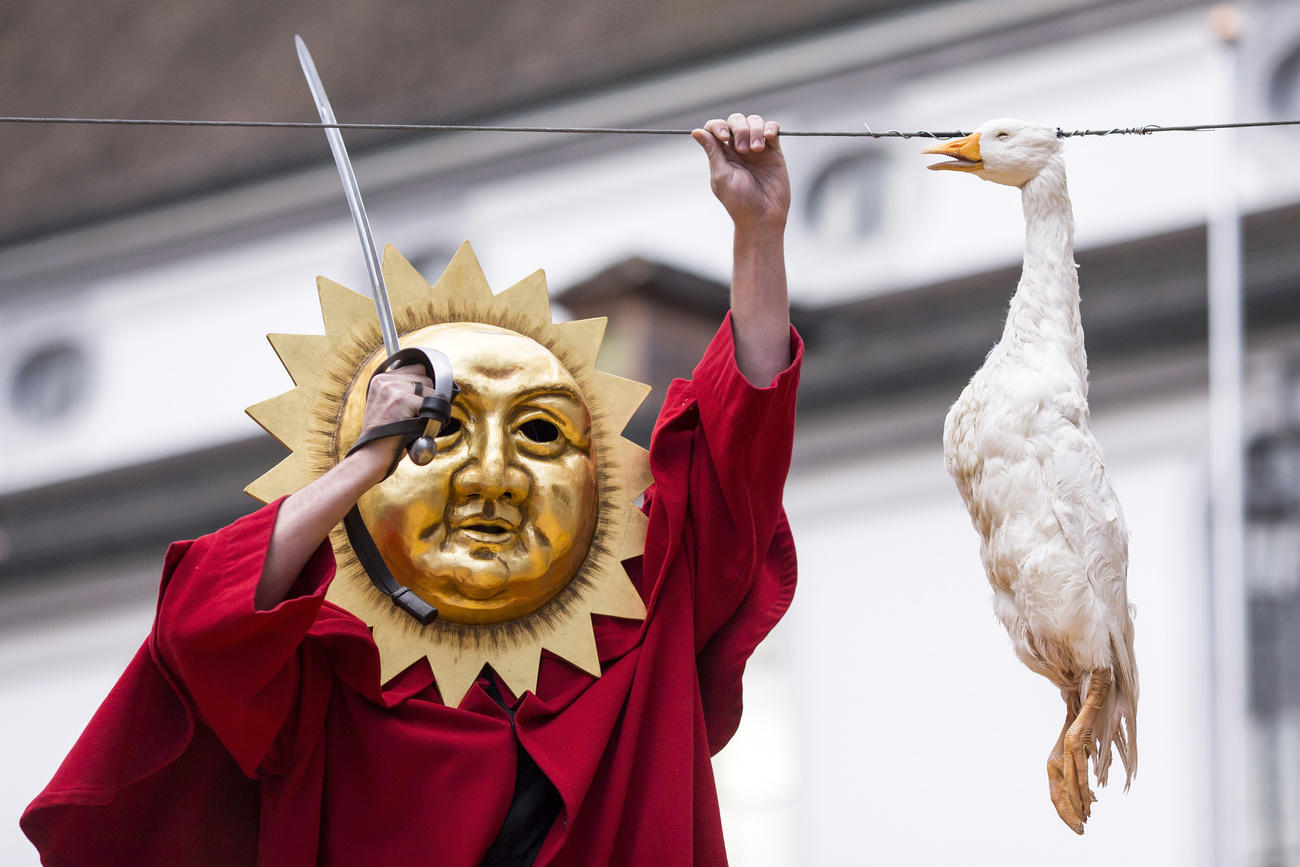
Happy – and creepy – New Year in Switzerland!

Whether it’s giving thanks for (or saying good riddance to) 2024 or hoping for a peaceful and prosperous 2025, billions of people around the world will be marking the New Year somehow – and the tradition-loving Swiss are no exception.
While many people are happy just to raise a glass of bubbly, others prefer to stuff 12 grapes into their mouths (Spain), wear colour-coded underwear (South America) or throw plates against their neighbours’ doors (Denmark).
The Swiss like to hang on to their crockery, but there’s no shortage of quirky – and often mildly alarming – customs, often going back hundreds of years.
Fountain-singing in Rheinfelden

This might look like something out of The Handmaid’s Tale, but the New Year’s Eve custom of Brunnensingen (fountain-singing) in Rheinfelden, northern Switzerland, dates back to 1541. Back then, locals tried to drive out the plague that was sweeping the country with Christmas carols (as we now know from the Covid pandemic, singing probably wasn’t the best idea). On December 24 and 31, the Sebastiani Brotherhood – 12 darkly dapper figures – parade through the old town, stopping at six fountains to sing the Christmas carol “Die Nacht, die ist so freudenreich” (the night is so joyful). For one hour all the town’s lights are turned off – practically the only illumination is a lantern carried by the singers. Very peaceful and atmospheric.
Evil mountain spirits in Interlaken

Considerably less peaceful is the Harder Potschete procession in Interlaken, central Switzerland. Below the Harder mountain peak in Interlaken is a cliff that resembles a man’s face and shoulders: the “Hardermannli”, the evil mountain spirit personified. On January 2 he descends into the valley with his wife and the Potschen, his followers. The Potschen, wearing impressive hand-carved wooden masks, strike fear and terror into the hearts of onlookers (via lots of shouting and a bit of chasing), while the noisy procession drives away evil winter spirits. The Hardermannli’s retreat signifies the victory of light over the darkness of night. After all the masks come off, everyone heads to the pub.
Piglet racing in Klosters

What better way to cure a New Year’s hangover than by screaming at some pigs to the sound of deafening cow bells? The Hotschrennen der Glückssäuli (lucky piglet race) in the mountain resort of Klosters in eastern Switzerland really puts the hog in Hogmanay. At 3pm on January 1, punters gather in the station squareExternal link and bet on up to ten little “lucky pigs”, who then race (at a fairly leisurely pace and often needing a bit of encouragement) around a snowy course. Even if your pig comes in last, there’s plenty of local food and (strong) drink to cheer/warm you up.
New Year’s Clauses in Appenzell

The New Year is celebrated twice in Appenzell, a rural region of northeastern Switzerland: on December 31 (the Gregorian calendar) and January 13 (the Julian calendar). At dawn, groups of men dressed up as Silvesterchläuse (New Year’s Clauses) make their way around local farms, where they form a circle, ring their bells and perform a wordless yodel. They wish the family a happy New Year and are given a bit of money before moving on to the next farm.
Nowadays the Silvesterchläuse are divided into three groups: the beautiful, the ugly and the beautifully ugly. The beautiful Chläuse wear full traditional dress decorated with silver lacing and elaborately decorated bonnets depicting scenes of everyday life. The ugly Chläuse wear shaggy coats covered in twigs, leaves or straw and cover their faces with demonic masks. The beautifully ugly Chläuse also use natural materials such as fir brushwood and moss for their costumes, but theirs are intricately designed, just like those of the beautiful.
Giant Silent Disco in Lausanne

If you’re looking for something a bit more 21st century, head to Place de la Gare in Lausanne, western Switzerland, between 8pm and 2am on December 31 for the Giant Silent Disco. Reserve your wireless headphones (for CHF30 ($33) plus a deposit) and switch between the three channels (and three DJs). The party looks hilarious from the outside: dancers pulling flash moves but without any music.
If you prefer a less beat-heavy atmosphere, there’s always the organ concert in Lausanne’s impressive cathedral at 10.30pm (repeated at 5pm on January 1).
Happy New Year – wherever you are!

More
They do what? Five frankly bizarre Swiss traditions

In compliance with the JTI standards
More: SWI swissinfo.ch certified by the Journalism Trust Initiative






























You can find an overview of ongoing debates with our journalists here . Please join us!
If you want to start a conversation about a topic raised in this article or want to report factual errors, email us at english@swissinfo.ch.